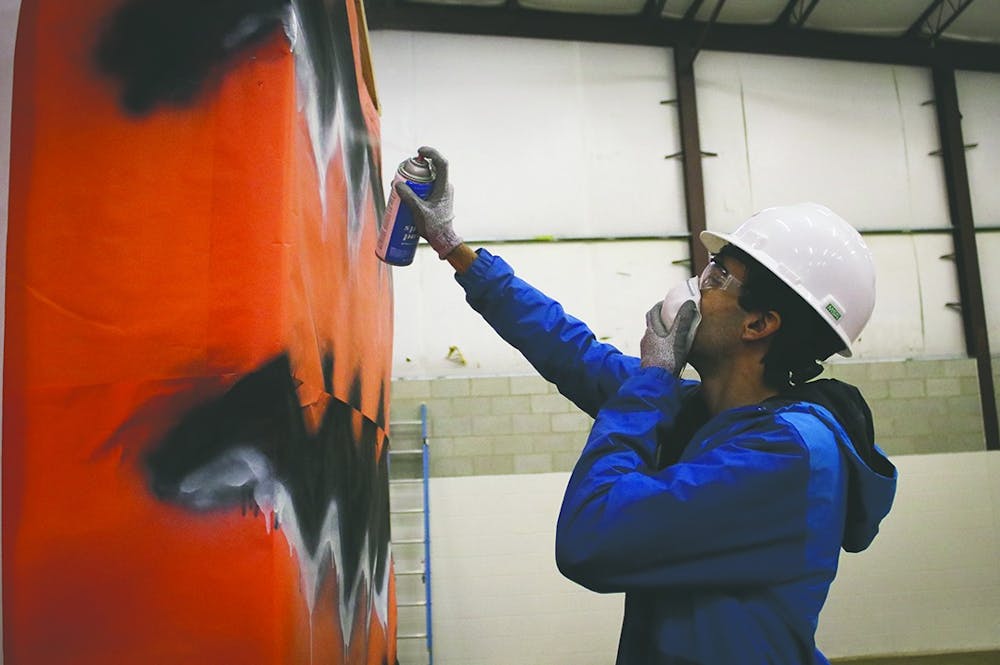University of South Carolina engineering students from the American Society of Mechanical Engineers and the Society of Hispanic Professional Engineers are gearing up for another year of the annual “Tiger Burn” tradition.
This year’s Tiger Burn will be held in the evening on Nov. 25 at the Greene Street Intramural Fields. These two societies have been working on the design and construction for the tiger since October.
The tiger is constructed in a warehouse on Catawba Street and requires 40 hours of work from the students. According to the president of the American Society of Mechanical Engineers, O’Dhori Prioleau, the students work on the construction every Tuesday and Thursday for a month and a half from 2 p.m. to 6 p.m. Though the society is for mechanical engineers, all engineering students are welcome to participate.
Prioleau is responsible for coordinating different parts of the event, such as making the schedule for building the structure and making a list of supplies needed for the construction.
“I think it’s cool to be a part of behind the scenes,” Prioleau said. “It’s something I can put on a resume, saying I managed this big project the student body will see.”
Prioleau said "trailers move every part" of the tiger from a warehouse on Catawba Street to the location of the Tiger Burn, where they assemble the actual tiger on the field. This year, the tiger is roughly 28 to 30 feet and around 10 feet wide.
Before construction begins, the tiger design is approved by the fire marshal to ensure safety.
“We build it in parts,” Prioleau said. “We have the head, the mid-body, the bottom and then the paws.”
Last year, students used a rope to burn the tiger, but mini-torches might be used this year, Prioleau said. A few students will carry mini-torches and all light the tiger at once.
In an email interview, the assistant director for campus programs Courtney Buzan said between 2,000 and 4,000 students attend the Tiger Burn annually. The event features Cocky, the Carolina Band and cheerleaders as part of the pep rally. It also features guest speakers, including a eulogist for the tiger.
This year, Dance Marathon morale team members Emma Chimera and John Cassibry will be student hosts, and the eulogist will be Jim Whitten from The Carolina Church.
Buzan works with the warehouse owners on building the tiger and coordinating the building schedule and supplies needed with the American Society of Mechanical Engineers. Buzan coordinates the “burning day” logistics with USCPD, the Carolina Band, the cheerleaders and other necessary staff members who make the event possible.
“It’s a wonderful privilege to be a part of such an iconic event at USC,” Buzan said. “Students take interest in various things throughout campus, and it’s hard to reach every student with campus entertainment and engagement. But everyone at USC knows our rivalry with Clemson, and therefore, every student knows or has at least heard of Tiger Burn and what the event details.”
Gabe Carrilho, president of the Society of Hispanic Professional Engineers, said his society collaborates with the American Society of Mechanical Engineers to put on the Tiger Burn every year. Carrilho's team is more broad in terms of the many disciplines within the engineering school.
His team is responsible for constantly evaluating the parts and changing designs to make sure the structure is sturdy, while the mechanical engineers are responsible for the actual building of the tiger.
“There’s a lot of pressure on us to make sure that this build is spaced and that it stands up and that it has an exciting burn,” Carrilho, a second-year mechanical engineering student, said. “The magnitude of this project is super exciting, and it’s really important, especially, to give the opportunity to these students to experience a project at this scale where their work is very valuable and will make or break our project.”
Carrilho said the professional development is crucial for this project, and the leadership skills his organization teaches are what makes this possible.
“The people aspect of this is the biggest part, and knowing how to manage people is a huge part of it,” Carrilho said.
The creation of the Tiger Burn tradition dates back 117 years. In 1902, a riot broke out when South Carolina upset Clemson. Clemson students were angry when a drawing of a gamecock crowing over a tiger appeared on a poster.
Clemson students warned the South Carolina students not to carry this poster in a victory parade, which took place on Main Street the next day. The Gamecock students ended up carrying the poster in the parade, and both schools’ students agreed to burn the poster to decrease tensions.
Gates will open at 6 p.m. at Greene Street Intramural fields.

